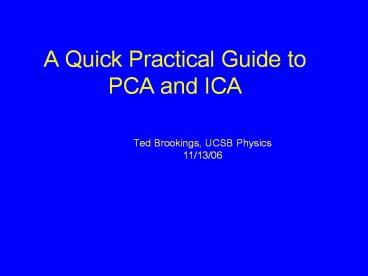A Quick Practical Guide to PCA and ICA - PowerPoint PPT Presentation
Title:
A Quick Practical Guide to PCA and ICA
Description:
Audio track recorded from multiple microphones. Series of brain images with multiple voxel ... Ultimately boils down to cross-correlations. ... – PowerPoint PPT presentation
Number of Views:243
Avg rating:3.0/5.0
Title: A Quick Practical Guide to PCA and ICA
1
A Quick Practical Guide to PCA and ICA
Ted Brookings, UCSB Physics 11/13/06
2
Blind Source Separation
- Suppose we have a data set that
- Has many independent components or channels
- Audio track recorded from multiple microphones
- Series of brain images with multiple voxel
- We believe is driven by several independent
processes - Different people speaking into microphones
- Different neuronal processes occurring within the
brain - We have no a priori notion of what those
processes look like
Our goal is to figure out what the different
processes are by grouping together data that is
correlated
3
Our Simple Example
- Driven by two sin signals with different
frequencies - 100 Sample Times
- 200 Channels
- 150 are a linear combination of Signal1 and
Signal2, with Poisson noise - 50 are Pure Poisson noise
4
PCA (Principle Component Analysis)
- Linear transform ---chooses a new basis
- Perpendicular
- First component explains the most variance,
second component explains the most remaining
variance, etc.
Finds a weight matrix W, and set of signals S,
that approximate the data X X W S The weight
matrix is the eigenvectors of the correlation
matrix, so the eigenvalues provide the order of
components
Image from http//www.umetrics.com/default.asp/p
agename/methods_MVA_how10/c/1
5
Spelling Things Out
The meaning of the basis equation e.g. if W
.6 and W .2, then X .6 S .2 S . That
is, X is actually being generated (at least
partly) by the processes S and S .
11 12
1 1 2
1
1 2
X is typically a time series ---that is, X is
measured at discrete intervals. However, our
basis doesnt change, because the fundamental
processes that are at work is presumed to be
constant. Because of this, W is constant in
time, and S changes with time. The end result of
PCA is then S(t), and W, which tells us the
activity of each component, and how to generate
the original data from the components.
6
PCA Results
Unsurprisingly, PCA discovers two dominant
components
We might expect trouble here PCA will probably
go diagonal
7
PCA Results
- Oops! The signals are mixed.
- But Theyre a lot cleaner, because PCA has
removed a lot of gaussian noise
8
ICA (Independent Component Analysis)
- Linear transform ---chooses a new basis
- NOT Perpendicular
- The basis is chosen to be maximally-independent
- There is no particular ordering of the basis
vectors
9
Er Maximally Independent?
Technical, and the definition depends somewhat on
the algorithm being used. Ultimately boils down
to cross-correlations. If two variables are
uncorrelated, they are independent.
Correlated
Uncorrelated
Images from web page by Aapo Hyvärinen,
http//www.cis.hut.fi/aapo/papers/NCS99web
10
Requirements
- At most one gaussian-distributed element of data
- The number of independent data must be greater
than the number of components m gt n. E.g.
number of microphones greater than number of
voices.
11
ICA Results
Ick! Might have expected this, because theres a
ton of gaussian noise in the system.
12
Do ICA on the Results of PCA!
- PCA cleans up the gaussian noise (and reduces the
dimension). - Most PCA packages incorporate PCA or some other
preprocessing for this reason. - ICA picks the basis that is maximally independent.
13
For More Info
- Check out Wikipedia (seriously).
- The articles on PCA/ICA
- Are actually good.
- Provide links to software packages for C, Java,
Matlab, etc. See especially FastICA. - Many of the external links provide good overviews
as well.
14
The Aftermath
Great! Now that we have what weve always wanted
(a list of components) what do we do with
them? Since ICA is blind it doesnt tells us
much about the components. We may simply be
interested in data reduction, or categorizing the
mechanisms at work. We may be interested in
components that correlate with some signal that
we drove the experiment with.































